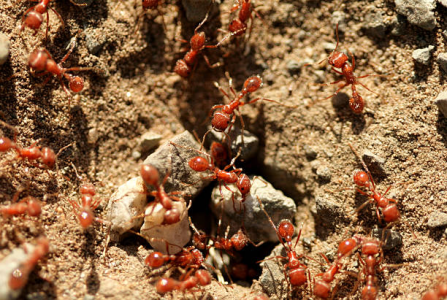Silent spread raises new fears for households everywhere
By
Gian T
- Replies 0
If you’ve been following recent reports, you may have heard warnings about a small but powerful invader spreading rapidly.
This pest isn’t just a nuisance in backyards and public spaces; it also poses risks to health, the environment, and everyday life.
The latest development? Fire ants have now been detected at five additional mine sites in Central Queensland, just weeks after their first appearance at BHP’s Broadmeadow coal mine.
This rapid spread has experts and authorities on high alert, and for good reason: these ants are responsible for hundreds of deaths in the US, and if they become established here, the consequences could be catastrophic.
The National Fire Ant Eradication Program (NFAEP) has traced the outbreak back to a single, seemingly innocent pallet of bricks.
These bricks, stored on infested soil, were transported more than 800km from a known fire ant biosecurity zone.
Once they arrived at the mine, the ants wasted no time in making themselves at home—and spreading.
Odour-detecting dogs (yes, you read that right—dogs trained to sniff out ants!) found the pests at several mines in the Central Highlands and Isaac Council regions.
The NFAEP hasn’t named the affected mines, but the Invasive Species Council is calling for the companies involved to take responsibility and pay for the clean-up.
Fire ants are not your average backyard nuisance. These aggressive insects can inflict painful stings, and for some people, a single encounter can trigger a life-threatening allergic reaction.
National allergy bodies estimate that if fire ants become established in Australia, up to 174,000 people could develop severe allergies.
But it’s not just our health at risk. Fire ants are notorious for damaging crops, infrastructure, and native wildlife.
They can thrive in 97 per cent of Australia’s environments, according to the NFAEP, and they’re experts at hitching rides on anything that touches the ground—soil, plants, machinery, even your gardening boots!
The recent outbreak has sparked a debate about who should foot the bill for eradication efforts. The Invasive Species Council’s advocacy manager, Reece Pianta, didn’t mince words:
'Every dollar and every drone we have should be focused on wiping out fire ants at the front lines near Brisbane, not cleaning up after corporate carelessness.'
While BHP has been praised for reporting the infestation and supporting surveillance, the Council says governments need to crack down on companies that breach movement restrictions.
After all, if resources are diverted to deal with preventable outbreaks, the entire national eradication effort could be undermined.
Tom Roberts, Director of Specialist Operations at the NFAEP, emphasised that eradicating fire ants is a 'shared community responsibility' and urged everyone—especially those sourcing equipment or materials from fire ant zones—to follow safe practices.
Red imported fire ants were first detected in South East Queensland in 2001.
Since then, a nationally coordinated, cost-shared program has been working to eradicate them, with a target date of 2032. It’s a race against time, as these ants are relentless invaders, and every new outbreak makes the job harder.
For many of us, gardening is a beloved pastime, and spending time outdoors is one of the joys of retirement.
But fire ants can turn a peaceful afternoon in the yard into a painful ordeal. Seniors are also more likely to have severe reactions to stings, so our community needs to stay informed and take precautions.

Have you spotted fire ants in your area? Do you have tips for keeping your garden pest-free? Share your experiences and advice in the comments below.
Read more: 'Start killing them fast': Dangerous critters flood typhoon-stricken homes
This pest isn’t just a nuisance in backyards and public spaces; it also poses risks to health, the environment, and everyday life.
The latest development? Fire ants have now been detected at five additional mine sites in Central Queensland, just weeks after their first appearance at BHP’s Broadmeadow coal mine.
This rapid spread has experts and authorities on high alert, and for good reason: these ants are responsible for hundreds of deaths in the US, and if they become established here, the consequences could be catastrophic.
The National Fire Ant Eradication Program (NFAEP) has traced the outbreak back to a single, seemingly innocent pallet of bricks.
These bricks, stored on infested soil, were transported more than 800km from a known fire ant biosecurity zone.
Once they arrived at the mine, the ants wasted no time in making themselves at home—and spreading.
Odour-detecting dogs (yes, you read that right—dogs trained to sniff out ants!) found the pests at several mines in the Central Highlands and Isaac Council regions.
The NFAEP hasn’t named the affected mines, but the Invasive Species Council is calling for the companies involved to take responsibility and pay for the clean-up.
Fire ants are not your average backyard nuisance. These aggressive insects can inflict painful stings, and for some people, a single encounter can trigger a life-threatening allergic reaction.
National allergy bodies estimate that if fire ants become established in Australia, up to 174,000 people could develop severe allergies.
But it’s not just our health at risk. Fire ants are notorious for damaging crops, infrastructure, and native wildlife.
They can thrive in 97 per cent of Australia’s environments, according to the NFAEP, and they’re experts at hitching rides on anything that touches the ground—soil, plants, machinery, even your gardening boots!
'Every dollar and every drone we have should be focused on wiping out fire ants at the front lines near Brisbane, not cleaning up after corporate carelessness.'
While BHP has been praised for reporting the infestation and supporting surveillance, the Council says governments need to crack down on companies that breach movement restrictions.
After all, if resources are diverted to deal with preventable outbreaks, the entire national eradication effort could be undermined.
Tom Roberts, Director of Specialist Operations at the NFAEP, emphasised that eradicating fire ants is a 'shared community responsibility' and urged everyone—especially those sourcing equipment or materials from fire ant zones—to follow safe practices.
Since then, a nationally coordinated, cost-shared program has been working to eradicate them, with a target date of 2032. It’s a race against time, as these ants are relentless invaders, and every new outbreak makes the job harder.
For many of us, gardening is a beloved pastime, and spending time outdoors is one of the joys of retirement.
But fire ants can turn a peaceful afternoon in the yard into a painful ordeal. Seniors are also more likely to have severe reactions to stings, so our community needs to stay informed and take precautions.
Key Takeaways
- Invasive fire ants have now spread to five more mine sites in Central Queensland, after originally being detected at a BHP coal mine just weeks ago.
- The outbreak was linked to a pallet of bricks stored on soil and transported over 800km from a known fire ant biosecurity zone, breaching strict movement restrictions.
- The Invasive Species Council and officials say mining companies responsible for breaching fire ant restrictions should cover the costs of containment and clean-up, rather than taxpayers.
- Authorities warn that eradicating fire ants is a national priority, urging strict industry cooperation and government enforcement to stop further outbreaks and resource diversion.
Read more: 'Start killing them fast': Dangerous critters flood typhoon-stricken homes







